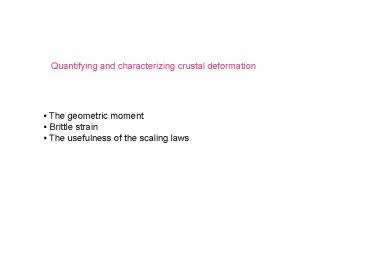Quantifying and characterizing crustal deformation PowerPoint PPT Presentation
Title: Quantifying and characterizing crustal deformation
1
Quantifying and characterizing crustal deformation
- The geometric moment
- Brittle strain
- The usefulness of the scaling laws
2
Quantifying and characterizing crustal
deformation the geometric moment
The geometric moment for faults is where U is
the mean geologic displacement over a fault whose
area is Af. Similarly, the geometric moment for
earthquakes is where ?U is the mean geologic
displacement over a fault whose area is Ae. Thus,
the geometry moment is simply the seismic moment
divided by the shear modulus.
3
Quantifying and characterizing crustal
deformation brittle strain
Brittle strains are a function of the geometric
moment as follows Kostrov, 1974 Geologic
brittle strain Seismic brittle strain
4
Quantifying and characterizing crustal
deformation brittle strain
To illustrate the logic behind these equations,
consider the simple case of a plate of brittle
thickness W and length and width l1 and l2,
respectively, that is being extended in the x1
direction by a population of parallel normal
faults of dip ?.
The mean displacement of the right-hand face
is which may be rearrange to give
5
Quantifying and characterizing crustal
deformation brittle strain
Geodetic data may also be used to compute brittle
strain
6
Quantifying and characterizing crustal
deformation brittle strain
Geologic brittle strain
- Advantages
- Long temporal sampling (Ka or Ma).
- Disadvantages
- Only exposed faults are accounted for.
- Cannot discriminate seismic from aseismic slip.
Geodetic brittle strain
- Advantages
- Accounts for all contributing sources, whether
buried or exposed. - Disadvantages
- Short temporal window.
7
Quantifying and characterizing crustal
deformation brittle strain
Seismic brittle strain
- Advantages
- Spatial resolution is better than that of the
geologic brittle strain. - Disadvantages
- Short temporal window.
Owing to their contrasting perspective, it is
interesting to compare
8
Quantifying and characterizing crustal
deformation brittle strain
Ward (1997) has done exactly this for the United
States
9
Quantifying and characterizing crustal
deformation brittle strain
For Southern and Northern California For
California
What are the implications of these results?
10
Quantifying and characterizing crustal
deformation fault scaling relations
The use of scaling relations allows one to
extrapolate beyond ones limited observational
range.
Displacement versus fault length
What emerges from this data is a linear scaling
between average displacement, U, and fault
length, L
11
Quantifying and characterizing crustal
deformation fault scaling relations
Cumulative length distribution of faults
Normal faults on Venus
Faults statistics obeys a power-law size
distribution. In a given fault population, the
number of faults with length greater than or
equal to L is where a and C are fitting
coefficients.
San Andreas subfaults
figure from Scholz
12
Quantifying and characterizing crustal
deformation fault scaling relations
These relations facilitate the calculation of
brittle strain. Recall that the geometric seismic
moment for faults is and since the
geometric seismic moment may be written as
This formula is advantageous since 1. It is
easier to determine L than U and A and 2. Since
one needs to measure U of only a few faults in
order to determine ? for the entire population.
13
Quantifying and characterizing crustal
deformation fault scaling relations
Furthermore, recall that the geologic brittle
strain is Using one can write
14
Quantifying and characterizing crustal
deformation earthquake scaling relations
Similarly, in order to calculate the brittle
strain for earthquake, one may utilize the
Gutenberg-Richter relations and the scaling of
co-seismic slip with rupture length.
Gutenberg-Richter relations
15
Quantifying and characterizing crustal
deformation earthquake scaling relations
Seismic moment versus source radius
- What emerges from this data is that co-seismic
stress drop is constant over a wide range of
earthquake sizes. - The constancy of the stress drop, ??, implies a
linear scaling between co-seismic slip, ?U, and
rupture dimensions, r
16
Quantifying and characterizing crustal
deformation brittle strain
Further reading
- Scholz C. H., Earthquake and fault populations
and the calculation of brittle strain,
Geowissenshaften, 15, 1997. - Ward S. N., On the consistency of earthquake
moment rates, geological fault data, and space
geodetic strain the United States, - Geophys. J. Int., 134, 172-186, 1998.

